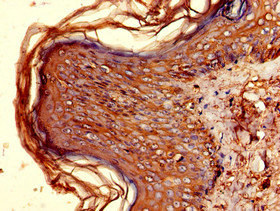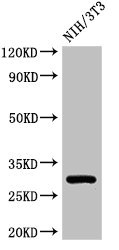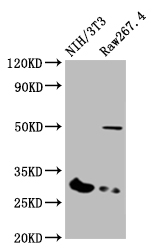HLA-DQB1 Antibody
-
货号:CSB-PA14849A0Rb
-
规格:¥440
-
促销:
-
图片:
-
Immunohistochemistry of paraffin-embedded human skin tissue using CSB-PA14849A0Rb at dilution of 1:100
-
Immunohistochemistry of paraffin-embedded human lymph node tissue using CSB-PA14849A0Rb at dilution of 1:100
-
Western Blot
Positive WB detected in: NIH/3T3 whole cell lysate
All lanes: HLA-DQB1 antibody at 3μg/ml
Secondary
Goat polyclonal to rabbit IgG at 1/50000 dilution
Predicted band size: 30 kDa
Observed band size: 30 kDa -
Western Blot
Positive WB detected in: NIH/3T3 whole cell lysate, RAW264.7 whole cell lysate
All lanes: HLA-DQB1 antibody at 1:2000
Secondary
Goat polyclonal to rabbit IgG at 1/50000 dilution
Predicted band size: 30 kDa
Observed band size: 30 kDa
-
-
其他:
产品详情
-
产品描述:
The HLA-DQB1 polyclonal antibody is an IgG that recognizes and binds specifically to the human and mouse HLA-DQB1 proteins. HLA-DQB1 protein mainly presents antigens to T cells and initiates an immune response against pathogens. It also plays a role in regulating immune responses and preventing the immune system from attacking the body's own tissues. Variations of the HLA-DQB1 protein can impact immune function and are associated with increased susceptibility to certain autoimmune diseases, such as type 1 diabetes and celiac disease.
The HLA-DQB1 polyclonal antibody is generated from rabbits. The recombinant human HLA class II histocompatibility antigen, DQ beta 1 chain protein (128-175aa) is used as the immunogen. After protein G purification, this HLA-DQB1 antibody reaches up to 95% in purity. It is suitable for use in ELISA, WB, and IHC applications.
-
产品名称:Rabbit anti-Homo sapiens (Human) HLA-DQB1 Polyclonal antibody
-
Uniprot No.:P01920
-
基因名:
-
别名:CELIAC1 antibody; DQ beta 1 chain antibody; DQB1_HUMAN antibody; HLA class II histocompatibility antigen antibody; HLA class II histocompatibility antigen; DQ beta 1 chain antibody; HLA class II histocompatibility antigen; DQ beta 2 chain antibody; HLA DQB antibody; HLA DQB1 antibody; HLA-DQB1 antibody; HLA-DQB2 antibody; IDDM1 antibody; Lymphocyte antigen antibody; Major histocompatibility complex class II beta antibody; Major histocompatibility complex; class II; DQ beta 1 antibody; MHC class II antigen DQB1 antibody; MHC class II antigen HLA DQ beta 1 antibody; MHC class II DQ beta chain antibody; MHC class II HLA DQ beta glycoprotein antibody; MHC class2 antigen antibody; MHC DQ beta antibody; OTTHUMP00000029167 antibody; OTTHUMP00000178569 antibody; OTTHUMP00000178570 antibody; OTTHUMP00000178571 antibody
-
宿主:Rabbit
-
反应种属:Human, Mouse
-
免疫原:Recombinant Human HLA class II histocompatibility antigen, DQ beta 1 chain protein (128-175AA)
-
免疫原种属:Homo sapiens (Human)
-
标记方式:Non-conjugated
本页面中的产品,HLA-DQB1 Antibody (CSB-PA14849A0Rb),的标记方式是Non-conjugated。对于HLA-DQB1 Antibody,我们还提供其他标记。见下表:
-
克隆类型:Polyclonal
-
抗体亚型:IgG
-
纯化方式:>95%, Protein G purified
-
浓度:It differs from different batches. Please contact us to confirm it.
-
保存缓冲液:Preservative: 0.03% Proclin 300
Constituents: 50% Glycerol, 0.01M PBS, pH 7.4 -
产品提供形式:Liquid
-
应用范围:ELISA, WB, IHC
-
推荐稀释比:
Application Recommended Dilution WB 1:200-1:3000 IHC 1:20-1:200 -
Protocols:
-
储存条件:Upon receipt, store at -20°C or -80°C. Avoid repeated freeze.
-
货期:Basically, we can dispatch the products out in 1-3 working days after receiving your orders. Delivery time maybe differs from different purchasing way or location, please kindly consult your local distributors for specific delivery time.
相关产品
靶点详情
-
功能:Binds peptides derived from antigens that access the endocytic route of antigen presenting cells (APC) and presents them on the cell surface for recognition by the CD4 T-cells. The peptide binding cleft accommodates peptides of 10-30 residues. The peptides presented by MHC class II molecules are generated mostly by degradation of proteins that access the endocytic route, where they are processed by lysosomal proteases and other hydrolases. Exogenous antigens that have been endocytosed by the APC are thus readily available for presentation via MHC II molecules, and for this reason this antigen presentation pathway is usually referred to as exogenous. As membrane proteins on their way to degradation in lysosomes as part of their normal turn-over are also contained in the endosomal/lysosomal compartments, exogenous antigens must compete with those derived from endogenous components. Autophagy is also a source of endogenous peptides, autophagosomes constitutively fuse with MHC class II loading compartments. In addition to APCs, other cells of the gastrointestinal tract, such as epithelial cells, express MHC class II molecules and CD74 and act as APCs, which is an unusual trait of the GI tract. To produce a MHC class II molecule that presents an antigen, three MHC class II molecules (heterodimers of an alpha and a beta chain) associate with a CD74 trimer in the ER to form a heterononamer. Soon after the entry of this complex into the endosomal/lysosomal system where antigen processing occurs, CD74 undergoes a sequential degradation by various proteases, including CTSS and CTSL, leaving a small fragment termed CLIP (class-II-associated invariant chain peptide). The removal of CLIP is facilitated by HLA-DM via direct binding to the alpha-beta-CLIP complex so that CLIP is released. HLA-DM stabilizes MHC class II molecules until primary high affinity antigenic peptides are bound. The MHC II molecule bound to a peptide is then transported to the cell membrane surface. In B-cells, the interaction between HLA-DM and MHC class II molecules is regulated by HLA-DO. Primary dendritic cells (DCs) also to express HLA-DO. Lysosomal microenvironment has been implicated in the regulation of antigen loading into MHC II molecules, increased acidification produces increased proteolysis and efficient peptide loading.
-
基因功能参考文献:
- This study showed for the first time that HLA-DQB1 genotypes is genetic markers associated with disability progression in Slovak MS patients. PMID: 29619906
- Studied association of HLADQB1*03 genotype and perioperative blood transfusion with regards to prognosis in surgically treated gastric cancer patients. PMID: 29667729
- heightened expression of HLA-DQB1 and -DQB2 in pre-implantation biopsies are promising tools for pre-transplant risk assessment of poor late graft function in transplants with kidneys from 18 to 49-year-old donors PMID: 29800590
- There was a significant association between HLA-DQB1*05 and (HLA-DRB1*14) and pemphigus vulgaris in Indian patients. PMID: 29582787
- In addition to the gene dosage effect confirmed in our report, and in contrast with previous studies, we found a raised risk for those patients with DQ2.2 heterodimers in trans configuration to DQ2.5 compared to DQ2.5 homozygous individuals. Therefore, in our population of patients with celiac disease (CD) the frequency of DQ2.2 acts as a factor that increases the genetic risk of developing CD. PMID: 29361871
- alleles DQB1*05:03 and DQB1*03:02 may be the susceptibility factors for pemphigus vulgaris;DQB1*05:01, DQB1*02, DQB1*06:01, and DQB1*03:03 are negatively associated with pemphigus vulgaris (Meta-Analysis) PMID: 29182409
- The significant differences in the frequency of HLA-DQ2 and HLA-DQ8 alleles in Syrian patients compared with controls demonstrated the importance role of these alleles in the development of CD and support the possibility of using HLA-DQ typing in confirmation of the disease. PMID: 29793442
- HLA-DRB1 and -DQB1 gene polymorphisms contribute to the development/protection of type 1 diabetes with/without autoimmune thyroiditis. PMID: 29958949
- This study suggests the involvement of rs6457617 locus as risk variant for susceptibility/severity to rheumatoid arthritis in Tunisian population. Secondly, it highlights the gene-gene interaction between HLA-DQB1 and HLA-DRB1. PMID: 29321349
- These data revealed that HLA-DQB1*06 had a protective effect on the course of HIV-1 and T-cell targeting of certain specific Nef epitopes, contributing to HIV-1 suppression. The results suggested the potential use of HLA-DQB1*06 and Nef core region in HIV-1 T-cell vaccine design. PMID: 28771107
- The patients with coexisting type 1 diabetes mellitus and celiac disease had an HLA-DRB1 and HLA-DQB1 profile that was more similar to diabetes patients than celiac disease patients. PMID: 28247576
- Bullous pemphigoid patients with the HLA-DQB1*03:01 allele show an increased T-cell avidity to several epitopes of BP180, particularly the BP180-NC16a domain. (Review) PMID: 28101965
- The presence of HLA-DQB1*0602 allele, but not HLA-DRB1*15 allele, was significantly associated with obstructive sleep apnea. PMID: 28875928
- these findings indicate that coronary artery disease in Southern Han Chinese is negatively associated with HLA-DQB1*03:01:01G and DQB1*05:03:01G PMID: 28624488
- in the Iranian population, HLA-DQB1*0201 appears to have protective role PMID: 28919585
- Our results implicated HLA-DQB1 in the development of ankylosing spondylitis PMID: 28743287
- HLA-DRB1/DQB1 gene variants appeared to modulate the alteration of the left posterior cingulate volume, hence modulating the susceptibility of Alzheimer's disease. PMID: 27056075
- HLA-DQ4 positive patients have a higher risk of Vogt-Koyanagi-Harada disease.Risk factor is HLA-DQB1*0401, while protective ones may include HLA-DQB1*0301, 0402, 0601, 0603. PMID: 29443768
- Longevity and lipid homeostasis were associated with HLA-DQB1 and suggest that immune gene variants could be involved in maintaining homeostasis and anti-aging in longevity. PMID: 29129831
- The results confirm the association of HLA-DRB1*04, specifically HLA-DRB1*04:05 subtype, and DRB1*04-DQB1*03 haplotype with rheumatoid arthritis susceptibility in Tunisians. PMID: 27580864
- The AG/GG genotype of rs9275572 and HLA-DQB1 Block2 CCCCC haplotype may have protective effects in hepatitis B virus-related hepatocellular carcinoma patients receiving hepatic resection. PMID: 27288300
- No association was found between HLA-DRB1 or -DQB1 alleles and 25OHD concentration PMID: 27623983
- the combination of rs6903608 and HLA-DQB1*05:03 may explain most of the HLA association signal in acquired thrombotic thrombocytopenic purpura PMID: 27762046
- This meta-analysis demonstrates that DQB1*02 and DQB1*06 may be negatively associated with RA. Conversely, DQB1*04 may confer susceptibility to RA. PMID: 28455285
- these results confirm an association of HLA-DQB1 alleles and haplotypes with polycystic ovary syndrome susceptibility in Bahraini PMID: 27505846
- HLA-DRB1*08:03:02 and HLA-DQB1*06:01:01 are associated with house dust mites (HMD)-sensitive AR and may confer a risk for development of allergic rhinitis in Han Chinese subjects sensitized to HDM. PMID: 27013183
- The DQB1*05:03 allele was associated with pemphigus vulgaris in our study as well as in various populations. PMID: 28197992
- the frequencies of HLA-DRB1*03:01 (pc = 0.0378, OR = 4.8) and HLA-DQB1*02:01 (pc = 0.021, OR = 4.8) alleles were significantly higher in patients with JORRP than in controls. In addition, HLA-DRB1*03:01 allele significantly correlated with aggressive JORRP PMID: 29106857
- association of DR4/DR8 heterozygous genotype suggested the pathologic importance of trans-complementing DQalpha-beta heterodimer molecules encoded by DQA1 allele of one haplotype and the DQB1 allele of the other haplotype, as it was proposed in the HLA association studies of Type 1 diabetes PMID: 29088299
- This study shows that clearance of HCV is associated with DQB1*03:01:01:01 allele and chronicity of HCV infection associated with the risk allele: DQB1*02:01:01. PMID: 27599887
- HLA-DQB1*06:02 does not seem to be associated with hypoxic ventilatory response or hypercapnic ventilatory response; however there are point wise, uncorrected significant associations between two TASK2/KCNK5 variants (rs2815118 and rs150380866) and hypercapnic ventilatory response PMID: 28045995
- we found that, among Caucasian patients treated with BoNT/A, DQB1*06:04 were higher in Ab-positive than in Ab-negative patients. The genetic linkage was on the threshold of corrected significance. PMID: 28385185
- HLA-DRB1*11, -DRB1*04 and -DQB1*03 allele frequencies between Black patients and healthy Black individuals revealed no significant difference in thrombotic thrombocytopenic purpura, but protective allele against TTP, HLA-DRB1*04, was dramatically decreased in Black individuals in comparison with White individuals PMID: 27383202
- HLA-DQbeta1 insertion confers achalasia risk in Polish and Swedish population. Frequency of the insertion shows a geospatial north-south gradient among Europeans. PMID: 26733285
- Amino-acid changes at position 66 and 67 confer susceptibility to age-related macular degeneration. PMID: 26733291
- Our study suggested no significant correlation between narcolepsy, MS and HLA-DQB1*06:02. The HLA-DQB1*06:02 allele alone was not sufficient to cause multiple sclerosis patients to develop narcolepsy. PMID: 28658402
- HLA-DRB1 and DQB1 genotyping reveals that X chromosome inactivation has a role in susceptibility to rheumatoid arthritis and systemic sclerosis PMID: 27355582
- Frequencies of DQB1*02:02 and DQB1*03:03 were not significantly different in juvenile-onset systemic sclerosis (SSc) versus controls. A marginally significant decrease in the frequency of DQB1*06 was observed in juvenile-onset SSc, mostly attributable to DQB1*06:02, which is in linkage disequilibrium with DRB1*15 PMID: 27214100
- DRB1*04 DQB1*02 and DRB1*07 DQB1*02 haplotypes were absent in cutaneous leishmaniasis patients. DRB1*15 DQB1*06 haplotype was over represented in controls. PMID: 27301744
- We demonstrated that allele HLA-DQB1*06 is associated with susceptibility to generalized vitiligo. PMID: 26769539
- Anti-LGI1 encephalitis was associated with the DQB1 haplotypes. PMID: 28026029
- In respect of HLA genes, factors are involved in the incidence of Recurrent aphthous stomatitis ; various HLA-DRB and HLA-DQB1 alleles and the related haplotypes are suggested to be the three main Recurrent aphthous stomatitis susceptibility factors in our population study. PMID: 27921409
- An eight-residue insertion in HLA-DQ[beta]1 was associated with idiopathic esophageal achalasia in a European sample. PMID: 26882171
- The present study identified an association of HLA-DQB1*03:01 with predisposition to, and DQB1*03:02 with resistance to, bronchiectatic airway disease or emphysema in RA. PMID: 27048628
- The results show that HLA-DQB1*05:02, HLA-DRB1*16:02 and HLA-B*67:01, in linkage disequilibrium with each other, are associated with susceptibility to RPC. PMID: 27241705
- The frequency of haplotype DRB1*090102-DQB1*060101 was significantly higher, whereas that of HLA-DRB1*070101-DQB1*020101 was significantly lower compared with healthy controls. The study indicated that HLA-DQB1*060101 alleles may be a potential predictor of high-risk IgAN susceptibility in Chinese Han population. PMID: 27896619
- DQB1 contributes to the genetic predisposition to narcolepsy type 1 (NT1), type 2 (NT2), idiopathic hypersomnia (IH) and no central hypersomnia subjects (no-CH) in Czech patients PMID: 28083611
- this study demonstrated that HLA class II allele DQB1*05:01 might contribute to clinical worsening in the cluster Guillain-Barre syndrome patients. PMID: 27485170
- HLA-DRB1*/DQB1* alleles and haplotypes strongly predispose South Indian population to ischaemic stroke PMID: 27105925
- this study shows association of HLA-DQB1 alleles with lupus nephritis in Moroccan population PMID: 27611588
显示更多
收起更多
-
亚细胞定位:Cell membrane; Single-pass type I membrane protein. Endoplasmic reticulum membrane; Single-pass type I membrane protein. Golgi apparatus, trans-Golgi network membrane; Single-pass type I membrane protein. Endosome membrane; Single-pass type I membrane protein. Lysosome membrane; Single-pass type I membrane protein. Note=The MHC class II complex transits through a number of intracellular compartments in the endocytic pathway until it reaches the cell membrane for antigen presentation.
-
蛋白家族:MHC class II family
-
数据库链接:
HGNC: 4944
OMIM: 604305
KEGG: hsa:3119
UniGene: Hs.409934
Most popular with customers
-
-
YWHAB Recombinant Monoclonal Antibody
Applications: ELISA, WB, IF, FC
Species Reactivity: Human, Mouse, Rat
-
Phospho-YAP1 (S127) Recombinant Monoclonal Antibody
Applications: ELISA, WB, IHC
Species Reactivity: Human
-
-
-
-
-

























